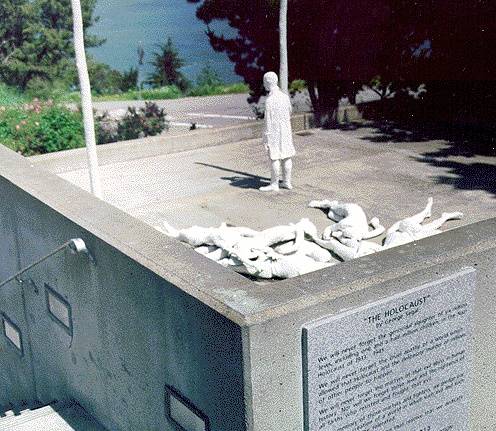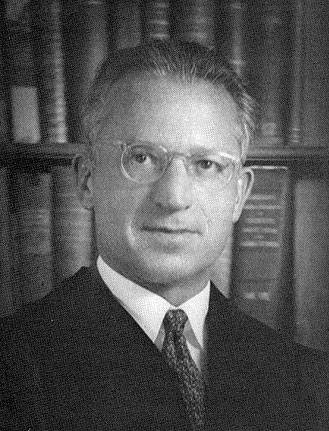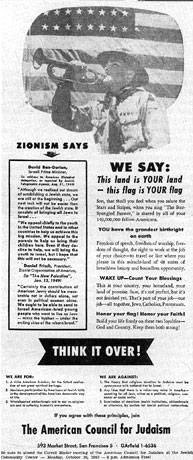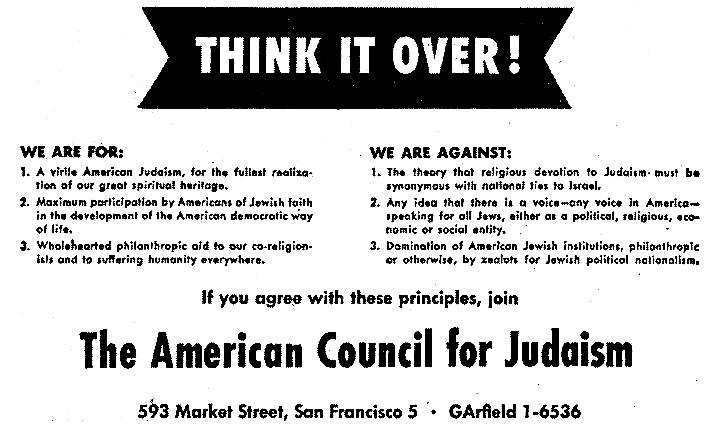San Francisco Jewish Elite: America's Leading Anti-Zionists: Difference between revisions
No edit summary |
m (Protected "San Francisco Jewish Elite: America's Leading Anti-Zionists": finished essay [edit=sysop:move=sysop]) |
||
| (One intermediate revision by the same user not shown) | |||
| Line 1: | Line 1: | ||
'''<font face = Papyrus> <font color = maroon> <font size = 4>Historical Essay</font></font> </font>''' | |||
''by Kate Shvetsky, 1997'' | |||
[[Image:jewishsf$holocaust-memorial.jpg]] | [[Image:jewishsf$holocaust-memorial.jpg]] | ||
| Line 46: | Line 50: | ||
In 1969 the American Council for Judaism had 117 names, and by the decade of 70s, ACJ ceased to exist. Nearly all old families would come to accept Zionism and regret their affiliation. Today Temple Emanu-El, as well as every other major temple in San Francisco, whole-heartedly supports a State for Jews. | In 1969 the American Council for Judaism had 117 names, and by the decade of 70s, ACJ ceased to exist. Nearly all old families would come to accept Zionism and regret their affiliation. Today Temple Emanu-El, as well as every other major temple in San Francisco, whole-heartedly supports a State for Jews. | ||
Latest revision as of 23:29, 10 January 2009
Historical Essay
by Kate Shvetsky, 1997
Holocaust Memorial by sculptor George Segal at the Palace of Legion of Honor in NW corner of San Francisco.
Photo: Chris Carlsson
The 1940s was a tumultuous decade for the Jewish community in San Francisco. A bitter debate ensued over and the merits of statehood for Jews--a debate about the nature of Judaism and the Jewish people. A group of wealthy, influential German families who'd descended from pioneers and who were now members of the city's Classical Reform "cathedral synagogue," Temple Emanu-El, led the anti-Zionist camp.
The central figure in this group against the formation of Israel was the rabbi of Temple Emanu-El -- Irving Reichert. His goal was to integrate Jews into American society: "Judaism is a religion, and a religion only." To him, "Zionism was a retreat from the highway of Jewish destiny and achievement in America to the dead end street of medieval ghettoims. One wonders what the Gentile world makes of all this Zionism. It is notorious that anti-Semites, when other arguments fail, sometimes succeed in prejudicing even friendly Christians against the Jew by quoting this type of nationalistic propaganda to convict us out of our own mouths for being a nationality embedded within a nation. Too dangerous a parallel between the insistence of Zionist spokesmen upon nationality and race and blood, and sinister pronouncement by Fascist leaders in European dictatorships. We may live to regret it."
Irving Reichart
Photo: Judah Magnus Museum
When the national conference of American Rabbis in 1942 passed a resolution supporting the creation of a Jewish army, Reichert and ninety-one other dissenting rabbis vowed to hold their own gathering. The "goy nineties," as the Zionists called them, after countering with a pronouncement that "dual citizenship in America is more than we can accept," formed the American Council for Judaism (ACJ), an organization of Reform rabbis and laypersons dedicated to combating Jewish nationalism. They tended to be elderly men who had begun their careers in the early part of the century, ministering to large, wealthy temples dominated by Germans. Lay leadership came almost exclusively from the board of director for Temple Emanu-El, including:
Daniel Koshland, one of the owners of Levi Strauss Company, JD and Harold Zellerbach, among the leading manufactures of paper in America, Mrs. I.W. Hellman, widow of one of the West's leading bankers, as well as other prominent attorneys, insurance executives, and real estate developers.
Images: Judah Magnus Museum
By early 1944 the San Francisco ACJ had over 100 members, employed a part-time secretary and opened a new office on Market Street. In 1945 membership peaked 1150 and 1400, one third of ACJ's national enrollment. The San Francisco chapter produced enough revenue to send the hard-pressed main office about twenty thousand dollars annually in mid-1940s, nearly 30 percent of the national operating budget. Each member of the Board personally solicited a hundred members and sent out packets of information on the council's aims to 3,000 others.
The ACJ struck a responsive chord among the members of SF Jewish elite, who in the midst of World War II joined the council almost to a man. Not only had anti-Zionism been an important component of Classical Reform Judaism for three generations, but it had been expounded in the Pulpit of Temple Emanu-El with special vigor by one of the giants of the American rabbinate, Jacob Voorsanger. Drawing on ancient texts, he argued that "our holy land, our promised land" is not "Turk-ridden" Palestine, but rather golden California with "its hills and dales."
It was not that the pioneer families were insensitive to the harrowing cries of Nazi-occupied Europe, but rather they interpreted Hitlerism as an aberration and believed in the integration of Jews into the host country as the natural order of things. Just as Voorsanger in 1900 predicted that the Jewish question would be solved with the overthrow of the Czar and establishment of democratic government in his place, so Reichert argued in 1944 that Jewish life would one day be resurrected in Germany. Unprecedented freedom, toleration, and prosperity in San Francisco had rendered the leaders idealistic about the fate of European Jewry.
There was little organized opposition to the ACJ until the end of the decade. The local Zionist Organization of America (ZOA) felt it had little to gain from an all-out public feud with the city's most prestigious Jewish leaders. When, immediately following World War II their great moment of opportunity arrived, the Zionists held rallies, disseminated literature, and took much pride in the fact that donations to the Jewish National Welfare Fund, much of which went to Palestine, doubled in the year 1946 alone to almost one and one-half million dollars.
In mid 1948 Reichert became the full-time Executive Director of ACJ's Western Region. A dynamic speaker and powerful writer, he joined the ACJ's professional staff at the most critical moment in the organization's history - the creation of the State of Israel. Daily newspapers brought home stories of heroism exhibited in War of Independence, and waves of emotion associated with the dramatic absorption of hundreds of thousands of new immigrants, many of them Holocaust survivors, swept the country.
For almost four years following independence, Reichert fought vigorously to hold the organization intact. Now that Ben Gurion had won a beachhead in Palestine, it was imperative to prevent him from "Zionizing" the American Jew, that is, raising money for the Jewish state, propagating the Hebrew language and notions of Jewish peoplehood, and encouraging aliyah (trips to the holy land). "Zionism uses the site of Israel to subvert our American view of Judaism and herd us into a new ghetto."
With an ambitious advertising campaign in the San Francisco Jewish Community Bulletin in fall 1949, Reichert designed hard-hitting verbal and visual messages, showing a Boy Scout playing a bugle in front of an American flag. The embattled editorial committee of the Bulletin had to postpone publication of a number of the ads.
After Israel's creation, membership in the ACJ slipped dramatically, and one-half the members refused to renew, including Haas, Koshland, and Dinkelspiel, unpersuaded by a letter predicting that the Jewish state would soon "drift into the Russian orbit." A number of younger leaders, such as Frank Sloss (son of Hattie Sloss), left and turned attention to United Jewish Appeal (UJA) and became active in their annual fund-raising campaign. Reichert's successor at Emanu-El had Labor Zionist sentiments, and attacked ACJ's ideology from the pulpit and soon thereafter convinced the Religious School Committee to adopt new textbooks that gave proper attention to Israel. By 1949 the Board had to confront the fact that the Council had virtually no members under the age of 30.
However, still working toward the ACJ's stated goal of resisting Zionist penetration of American Jewish community, Reichert claimed, "The bulk of funds raised by UJA passes to Israel in a manner defeating final accountability. The ends to which the funds are put include governmental purposes of the State of Israel, political purposes in the US and Israel, and indoctrination of American Jews in Zionist philosophy." The national ACJ voted to adopt a proposal calling on US Dept. of Justice to investigate the UJA.
They also attacked Israel in the arena of Middle Eastern politics. After being received in five Arab countries in 1955 they wrote glowing treatment of Jews in Egypt, Syria, Lebanon, Morocco, and even Iran. A visit to Jerusalem convinced them that "to be a Jew here in Israel is to share a nationalism that has ugly overtones of racism and exclusivism." They labeled Israel the aggressor of June 1967 war, assisted several Arab diplomats in preparing speeches they delivered on the conflict before the UN. In a speech in 1949 Reichert drew thinly veiled comparisons between the Hitler Youth and Zionist programs aimed at college students, declaring Jewish nationalism "a totalitarian movement with "its tentacles in all our personal lives."
In 1969 the American Council for Judaism had 117 names, and by the decade of 70s, ACJ ceased to exist. Nearly all old families would come to accept Zionism and regret their affiliation. Today Temple Emanu-El, as well as every other major temple in San Francisco, whole-heartedly supports a State for Jews.




